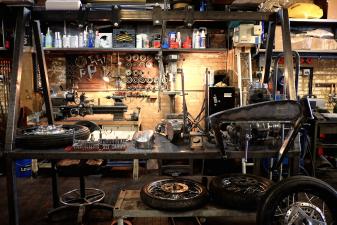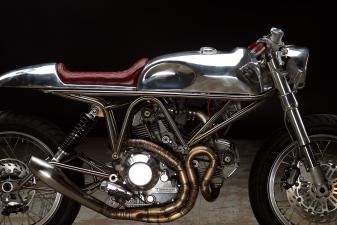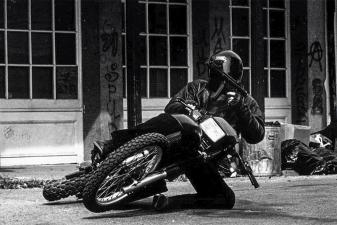The Victory War Room
The Secret Space Where Victory Motorcycles Were Created - By Michael Dapper

During research for Victory Motorcycles 1998–2017 (April 2018), author and long-time Victory media representative, Mike Dapper interviewed Bob Nygaard, Polaris Hall of Fame Inductee and key figure in getting Victory motorcycles on the road.
In this exclusive interview, Nygaard takes us into the Victory War Room where discussions of adding a motorcycle division to the Polaris line first took place. He outlines the initial inspirations, motivations, and concerns that surrounded Victory’s creation, including what would become the brand’s ultimate challenge: to create an American motorcycle that could compete with the market’s enduring loyalty to the Harley Davidson name.
Since we couldn’t fit it all into the book, we included it here on the Octane FUEL Blog. Check back for upcoming posts on the making of Victory Motorcycles, with original articles and insider interviews you won’t find anywhere else—not even in the book!
---------------------------
Forget the factory in Spirit Lake, Iowa. The true birthplace of Victory motorcycles was a non-descript two-story building in Plymouth, a suburb just west of Minneapolis.
When Polaris used the building as its corporate headquarters from the 1970s into the 1990s, there was a large upstairs conference room with a private bathroom and windows overlooking nearby Hwy. 169. When no meetings were taking place, the bathroom could provide an employee with a momentary escape from the company’s busy pace, thin staffing, and heavy individual workloads. In 1995, access to the room was cut off, and employees – including myself– were denied the opportunity for a moment’s peace.
The room had been closed and locked because two product managers, Bob Nygaard (snowmobiles) and Matt Parks (ATVs), were using it as a “War Room.” Around 1994, then-Polaris CEO W. Hall Wendel, Jr., had ordered them to begin researching business opportunities the company could pursue to fuel further growth. Nygaard and Parks investigated dozens of businesses that offered market potential and, ideally, would let the company further utilize its manufacturing expertise.
The duo eventually concluded Polaris could successfully enter the heavyweight cruiser motorcycle business, and the company did so in the late 1990s with its new Victory Motorcycle division. The motorcycle business appealed greatly to Parks, who was long an avid rider, and who became Victory’s original general manager (then a Polaris division’s highest staff position).
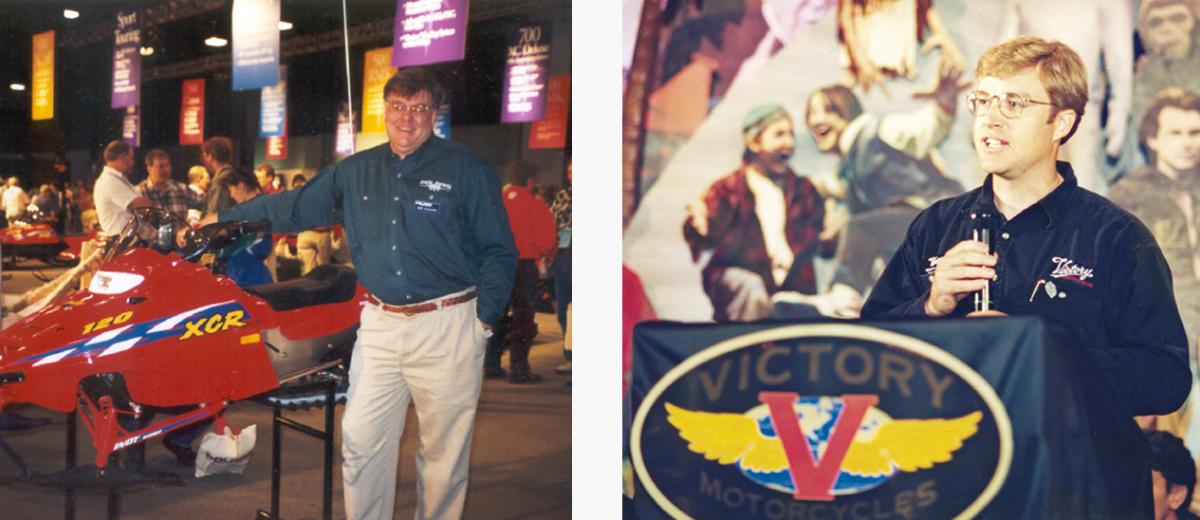 Left: Bob Nygaard, then general manager of the Polaris snowmobiles division, posed with a youth model at a dealer sales meeting. Bob Nygaard
Left: Bob Nygaard, then general manager of the Polaris snowmobiles division, posed with a youth model at a dealer sales meeting. Bob Nygaard
Right: Matt Parks looked at everyting from go-karts to chainsaws as possible avenues for Polaris. When the results of a 1993 survey showed a high number of Polaris owners were also motorcyclists, Parks and company executives began to seriously consider adding a motorcycle to the Polaris line. Parks is shown at the June 1997 press introduction. Victory
Nygaard—who was in his second decade with Polaris—wasn’t a bike guy, and wasn’t as convinced about the motorcycle opportunity. Nygaard is a Polaris legend. He worked with the company for 28 years, and at one time, he was product manager (which was then a division’s top position) for three product lines at the same time – snowmobiles, ATVs, and personal watercraft. (Remember mention of the company’s thin staffing?) A Polaris Hall of Fame inductee, Nygaard described the War Room and the business research process at the origins of Victory.
“In the 1990s, the economy was roaring along, and Harley-Davidson was the darling of the financial community and the stock market,” Nygaard recalled in an interview earlier this month. “There were things that popped up [in our research] like, for lack of a better term, dune buggies, which were very much a West Coast thing at the time, and which would later [for Polaris] become the RANGER and RZR business. We also looked at aspects of the marine business.
“After we went through all the filters, the motorcycle business probably had greater appeal in terms of how the stock market and shareholders would look at it because of how well Harley was doing. I had no experience with motorcycles. I didn’t ride bikes and didn’t know that business. Matt had a passion for it. He was a rider and he’s the guy who really knew the motorcyclist.”
Nygaard knew Polaris, including its strengths and weaknesses. He didn’t feel the company – and maybe not any company – could successfully compete against the incredible brand loyalty Harley’s customers displayed.
“I was not a proponent of [Polaris] getting into the motorcycle business, and I was one of the only ones, if not the only one,” he said. “I could help you with market research and industry statistics and a pro forma [that would help project business results], but I couldn’t see how we could compete with the lifestyle, the culture surrounding Harley.
“If you could get Neil Young or Bob Seger to write a song about Victory Motorcycles, I’ll be on board,” he laughed. “But without that, no.”
He said the company investigated acquiring the Indian Motorcycle name and branding, which would have given the new motorcycle operation instant market appeal. But those assets were tangled in an unresolved legal dispute, and it wasn’t even clear who truly owned the rights to Indian branding.
So, in that second-story room of what was then called 1225 County Road 18, it was determined Polaris should enter the heavyweight cruiser motorcycle business. In the same building, the company’s directors approved the move, and Victory Motorcycles was born.
Today, the building that housed the Victory War Room is a U-Haul Moving & Storage facility.
 The original photo (a print, not digital!) is lost to the ages, but this is a scan from a late 1998 issue of Polaris SPIRIT Magazine. As legendary Victory rider Joe Klein made the first coast-to-coast ride on a Victory, he stopped at Polaris corporate headquarters. Several employees came out to pose for this photo. The building on the left is the birthplace of Victory, the home to the original Victory War Room. Michael Dapper
The original photo (a print, not digital!) is lost to the ages, but this is a scan from a late 1998 issue of Polaris SPIRIT Magazine. As legendary Victory rider Joe Klein made the first coast-to-coast ride on a Victory, he stopped at Polaris corporate headquarters. Several employees came out to pose for this photo. The building on the left is the birthplace of Victory, the home to the original Victory War Room. Michael Dapper
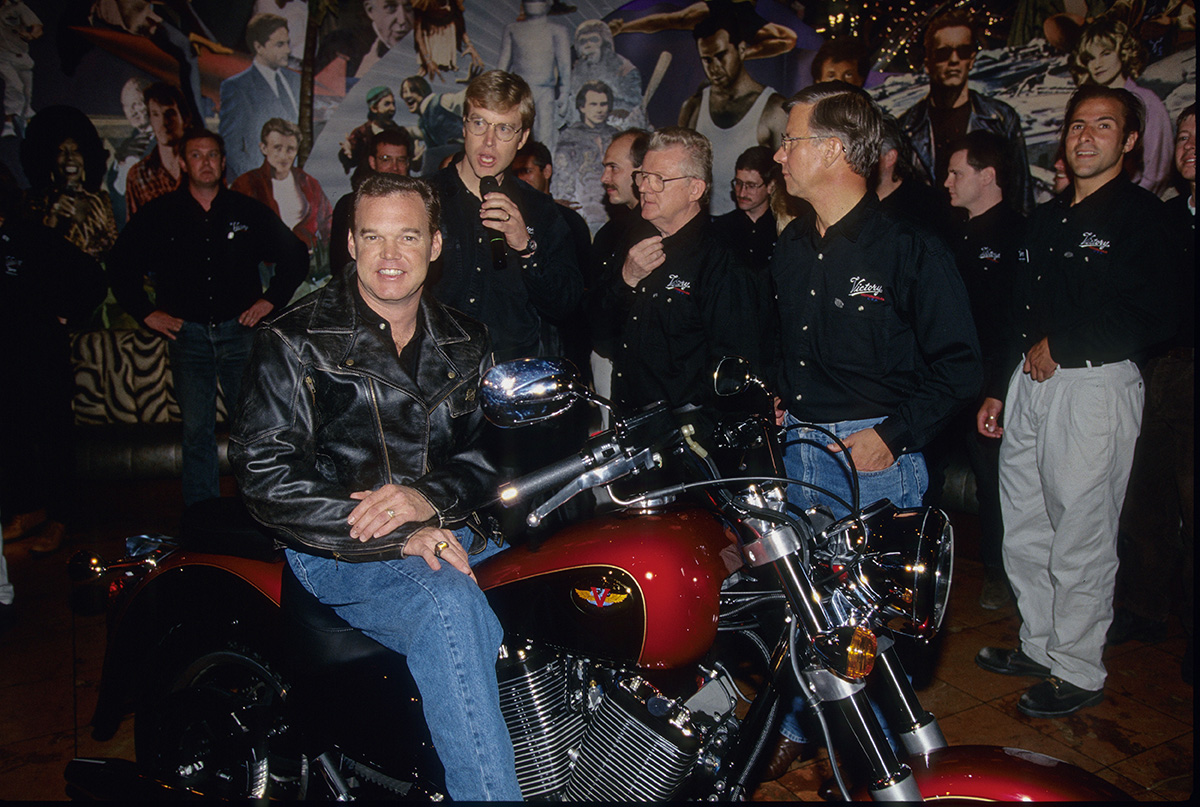 On the day the V92C was introduced, IndyCar racer Al Unser, Jr., posed on the pre-production bike while Victory G.M. Matt Parks addressed the crowd. To the right of Parks are then-Polaris President Ken Larson and then-CEO W. Hall Wendel, Jr. Victory
On the day the V92C was introduced, IndyCar racer Al Unser, Jr., posed on the pre-production bike while Victory G.M. Matt Parks addressed the crowd. To the right of Parks are then-Polaris President Ken Larson and then-CEO W. Hall Wendel, Jr. Victory
 Check back for upcoming posts on the making of Victory Motorcycles 1998-2017, available for pre-order now!
Check back for upcoming posts on the making of Victory Motorcycles 1998-2017, available for pre-order now!
In this exclusive interview, Nygaard takes us into the Victory War Room where discussions of adding a motorcycle division to the Polaris line first took place. He outlines the initial inspirations, motivations, and concerns that surrounded Victory’s creation, including what would become the brand’s ultimate challenge: to create an American motorcycle that could compete with the market’s enduring loyalty to the Harley Davidson name.
Since we couldn’t fit it all into the book, we included it here on the Octane FUEL Blog. Check back for upcoming posts on the making of Victory Motorcycles, with original articles and insider interviews you won’t find anywhere else—not even in the book!
---------------------------
Forget the factory in Spirit Lake, Iowa. The true birthplace of Victory motorcycles was a non-descript two-story building in Plymouth, a suburb just west of Minneapolis.
When Polaris used the building as its corporate headquarters from the 1970s into the 1990s, there was a large upstairs conference room with a private bathroom and windows overlooking nearby Hwy. 169. When no meetings were taking place, the bathroom could provide an employee with a momentary escape from the company’s busy pace, thin staffing, and heavy individual workloads. In 1995, access to the room was cut off, and employees – including myself– were denied the opportunity for a moment’s peace.
The room had been closed and locked because two product managers, Bob Nygaard (snowmobiles) and Matt Parks (ATVs), were using it as a “War Room.” Around 1994, then-Polaris CEO W. Hall Wendel, Jr., had ordered them to begin researching business opportunities the company could pursue to fuel further growth. Nygaard and Parks investigated dozens of businesses that offered market potential and, ideally, would let the company further utilize its manufacturing expertise.
The duo eventually concluded Polaris could successfully enter the heavyweight cruiser motorcycle business, and the company did so in the late 1990s with its new Victory Motorcycle division. The motorcycle business appealed greatly to Parks, who was long an avid rider, and who became Victory’s original general manager (then a Polaris division’s highest staff position).
 Left: Bob Nygaard, then general manager of the Polaris snowmobiles division, posed with a youth model at a dealer sales meeting. Bob Nygaard
Left: Bob Nygaard, then general manager of the Polaris snowmobiles division, posed with a youth model at a dealer sales meeting. Bob NygaardRight: Matt Parks looked at everyting from go-karts to chainsaws as possible avenues for Polaris. When the results of a 1993 survey showed a high number of Polaris owners were also motorcyclists, Parks and company executives began to seriously consider adding a motorcycle to the Polaris line. Parks is shown at the June 1997 press introduction. Victory
Nygaard—who was in his second decade with Polaris—wasn’t a bike guy, and wasn’t as convinced about the motorcycle opportunity. Nygaard is a Polaris legend. He worked with the company for 28 years, and at one time, he was product manager (which was then a division’s top position) for three product lines at the same time – snowmobiles, ATVs, and personal watercraft. (Remember mention of the company’s thin staffing?) A Polaris Hall of Fame inductee, Nygaard described the War Room and the business research process at the origins of Victory.
“In the 1990s, the economy was roaring along, and Harley-Davidson was the darling of the financial community and the stock market,” Nygaard recalled in an interview earlier this month. “There were things that popped up [in our research] like, for lack of a better term, dune buggies, which were very much a West Coast thing at the time, and which would later [for Polaris] become the RANGER and RZR business. We also looked at aspects of the marine business.
“After we went through all the filters, the motorcycle business probably had greater appeal in terms of how the stock market and shareholders would look at it because of how well Harley was doing. I had no experience with motorcycles. I didn’t ride bikes and didn’t know that business. Matt had a passion for it. He was a rider and he’s the guy who really knew the motorcyclist.”
Nygaard knew Polaris, including its strengths and weaknesses. He didn’t feel the company – and maybe not any company – could successfully compete against the incredible brand loyalty Harley’s customers displayed.
“I was not a proponent of [Polaris] getting into the motorcycle business, and I was one of the only ones, if not the only one,” he said. “I could help you with market research and industry statistics and a pro forma [that would help project business results], but I couldn’t see how we could compete with the lifestyle, the culture surrounding Harley.
“If you could get Neil Young or Bob Seger to write a song about Victory Motorcycles, I’ll be on board,” he laughed. “But without that, no.”
He said the company investigated acquiring the Indian Motorcycle name and branding, which would have given the new motorcycle operation instant market appeal. But those assets were tangled in an unresolved legal dispute, and it wasn’t even clear who truly owned the rights to Indian branding.
So, in that second-story room of what was then called 1225 County Road 18, it was determined Polaris should enter the heavyweight cruiser motorcycle business. In the same building, the company’s directors approved the move, and Victory Motorcycles was born.
Today, the building that housed the Victory War Room is a U-Haul Moving & Storage facility.
 The original photo (a print, not digital!) is lost to the ages, but this is a scan from a late 1998 issue of Polaris SPIRIT Magazine. As legendary Victory rider Joe Klein made the first coast-to-coast ride on a Victory, he stopped at Polaris corporate headquarters. Several employees came out to pose for this photo. The building on the left is the birthplace of Victory, the home to the original Victory War Room. Michael Dapper
The original photo (a print, not digital!) is lost to the ages, but this is a scan from a late 1998 issue of Polaris SPIRIT Magazine. As legendary Victory rider Joe Klein made the first coast-to-coast ride on a Victory, he stopped at Polaris corporate headquarters. Several employees came out to pose for this photo. The building on the left is the birthplace of Victory, the home to the original Victory War Room. Michael Dapper On the day the V92C was introduced, IndyCar racer Al Unser, Jr., posed on the pre-production bike while Victory G.M. Matt Parks addressed the crowd. To the right of Parks are then-Polaris President Ken Larson and then-CEO W. Hall Wendel, Jr. Victory
On the day the V92C was introduced, IndyCar racer Al Unser, Jr., posed on the pre-production bike while Victory G.M. Matt Parks addressed the crowd. To the right of Parks are then-Polaris President Ken Larson and then-CEO W. Hall Wendel, Jr. Victory Check back for upcoming posts on the making of Victory Motorcycles 1998-2017, available for pre-order now!
Check back for upcoming posts on the making of Victory Motorcycles 1998-2017, available for pre-order now! 


